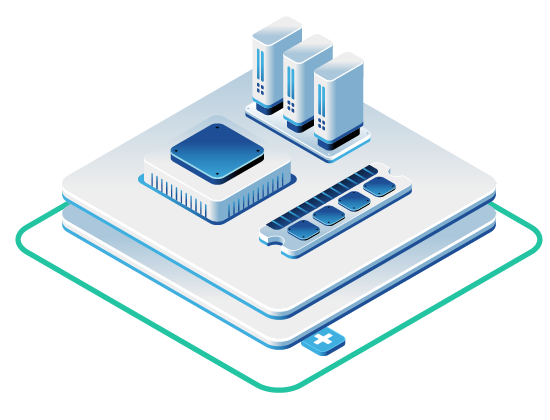In this article
When managing an OpenStack cloud that needs to support multiple users, teams, or distinct organizations, multi-tenancy becomes a must. At its core, multi-tenancy in OpenStack is about securely sharing your cloud infrastructure. It lets different groups, called tenants (often interchangeably referred to as projects within OpenStack), use the same underlying hardware but keeps their virtual machines, networks, and storage completely separate and private.
Understanding how to work with multi-tenancy is helpful for several reasons:
- Resource Optimization: Pooling infrastructure resources leads to higher utilization and can greatly reduce costs.
- Secure Isolation: Each tenant operates within their own defined boundaries, ensuring the privacy and security of their virtual machines, networks, and data.
- Centralized Management: While managing multiple tenants introduces complexity, OpenStack provides centralized control for overseeing the infrastructure, applying global policies, and managing resources efficiently across all tenants.
Making this functionality happen are these core OpenStack services:
- Keystone: Manages identity, authentication, and authorization.
- Nova: Handles compute resources (VM lifecycle management).
- Neutron: Provides network services and ensures network isolation.
- Cinder and Swift: Manage block and object storage, respectively.
Of course, it’s not without its hurdles:
- Resource Contention: Tenants can sometimes impact each other’s performance (“noisy neighbors”) if resource allocation isn’t managed well.
- Security Configuration Complexity: Setting up all the permissions and network rules correctly takes careful planning.
- Storage Management: Giving each tenant the storage performance and privacy they need requires smart configuration.
Setting up multi-tenancy involves defining projects/tenants, assigning user roles, setting resource limits (quotas), and configuring isolated network and storage resources. Furthermore, ongoing monitoring, regular security reviews, and performance tuning are vital for maintaining a stable, secure, and efficient multi-tenant environment.
Quick Tip: Get comfortable with the OpenStack CLI (or Horizon) for setting up projects. And definitely use resource quotas – they’re your best friend for keeping usage fair and balanced.
Core Components Involved in OpenStack Multi-Tenancy
OpenStack doesn’t magically create isolated environments. Multi-tenant capabilities are delivered through the coordinated efforts of its core services. Each plays a distinct role in partitioning resources and enforcing boundaries to allow secure sharing of the infrastructure.
Keystone: Identity, Authentication, and Access Control
Keystone acts as the central identity management and access control point for OpenStack. It’s fundamental to multi-tenancy, providing mechanisms to:
- Manage Domains and Projects: Keystone organizes users and resources. Projects are the basic unit of ownership for resources (VMs, volumes, networks). Domains are an optional higher level, useful for grouping multiple projects, maybe under different departments or actual customers.
- Enforce Role-Based Access Control (RBAC): Keystone uses roles (like ‘admin’, ‘member’, ‘reader’) assigned to users within specific projects or domains to control permissions very granularly. Who can launch a VM? Who can only view resources? Keystone decides based on these roles.
- Handle Authentication: It issues and verifies tokens, the digital credentials users and services use to prove their identity when making requests.
- Keep a Service Catalog: It tells users and other services where to find the API endpoints for Nova, Neutron, Cinder, etc.
Without Keystone defining these boundaries and enforcing access rules, true multi-tenancy wouldn’t be possible.
Nova: Managing Compute Resources
Nova is responsible for managing all your virtual machines (compute instances). In a multi-tenant world, its job includes:
- Working with Hypervisors: Nova directs hypervisors (like KVM or VMware) which actually provide the fundamental isolation between VMs running on the same physical host.
- Smart Scheduling: It decides where new VMs should run, considering available resources (CPU, RAM) and respecting the quotas assigned to the tenant’s project.
- Lifecycle Management: It handles everything from creating and starting VMs to shutting them down, resizing, and taking snapshots – always ensuring these actions happen within the right tenant’s project.
- Applying Security Groups: It ensures the firewall rules defined in Neutron (Security Groups) get attached to the correct VM network interfaces.
Nova makes sure compute resources are distributed fairly and that tenant VMs operate independently.
Neutron: Providing Network Isolation
Neutron provides Networking-as-a-Service. Its role in multi-tenancy is creating virtual network infrastructure and keeping one tenant’s traffic completely separate from another’s. It achieves this through:
- Tenant-Specific Networks: It lets you create distinct Layer 2 networks and Layer 3 subnets that belong only to a specific project.
- Traffic Encapsulation: Often, Neutron uses overlay technologies like VXLAN or GRE. Think of these as creating private tunnels for each tenant’s network traffic, allowing it to cross the shared physical network infrastructure without mixing.
- Security Groups: These act as distributed, stateful firewalls for VMs. Each project can define its own sets of rules controlling what traffic is allowed in or out of its instances. Neutron enforces these rules at the virtual network port level.
- Isolated Routing: Using concepts like Linux network namespaces and virtual routers, Neutron can give tenants their own private routing environments, connecting their virtual networks or providing access to external networks securely.
Thanks to Neutron, each tenant gets their own virtual networking stack, ensuring privacy and preventing interference.
Cinder and Swift: Handling Tenant Storage
Storage needs dedicated attention in a multi-tenant setup. OpenStack provides two main services: Cinder for block storage (like virtual hard drives) and Swift for object storage (for storing files, backups, media, etc.). Both are built with tenancy in mind:
Cinder (Block Storage):
- Creates volumes that are owned by specific projects. Access controls prevent one tenant from accessing another’s volumes.
- Manages snapshots and backups, often tied to the owning project.
- Enforces storage quotas (number of volumes, total size) per project.
- Can connect to various storage backends (SAN, NAS, Ceph) providing flexibility while maintaining tenant separation logically.
Swift (Object Storage):
- Provides separate containers (like buckets in S3) for each tenant to store their objects.
- Uses Access Control Lists (ACLs) to manage permissions on containers and objects finely.
- Ensures unique storage namespaces so tenants don’t clash.
- Offers features like data replication for durability and optional encryption.
Cinder and Swift work together to give tenants secure, isolated access to storage resources, tailored to their quotas and needs, all while potentially using shared physical storage underneath.
Setting Up Your Multi-Tenant OpenStack Environment
Configuring OpenStack for multi-tenancy involves getting these isolation parameters right, whether you’re on a platform like OpenMetal or managing your own private cloud.
1. Laying the Foundation: Projects and Management
Everything starts with creating projects (your tenants). You’ll use the OpenStack CLI or the Horizon dashboard for this.
Example CLI Commands:
# Maybe create a domain first if you need to group projects
openstack domain create customer_domain
# Create a project (tenant) - assign it to a domain if you use them
openstack project create --domain default project_one # Using the default domain
openstack project create --domain customer_domain project_two # In your custom domain
Tips for Keeping Projects Organized:
- Use a consistent naming scheme – future you will thank you.
- Keep track of who owns each project and its purpose.
- Consider using domains or hierarchies if you have a complex structure (like multiple departments or clients).
2. Defining Roles: Who Can Do What?
Roles are key to security. You need to define what different types of users can do within a project.
Common Roles:
| Role | Typical Access Level | Common Uses |
|---|---|---|
admin | Full control within their scope | Cloud admins, project infrastructure managers |
member | Can create/manage resources (VMs, volumes) | Developers, application owners |
reader | View-only access | Monitoring, auditing |
Best Practices for Roles:
- Least Privilege First: Always grant the minimum permissions needed. Don’t give everyone admin!
- Regular Audits: Check role assignments periodically. People change roles, projects end.
- Document: Know what your roles mean, especially if you create custom ones for specific tasks.
3. Setting Limits: Resource Quotas
Quotas are your safety net. They prevent any single tenant from accidentally (or intentionally) consuming all available resources.
Example Starting Quotas (Tune These For Your Environment!):
| Resource Type | Example Starting Quota | Why It Matters |
|---|---|---|
| VCPUs | 20 | Limits total CPU cores |
| RAM (MB) | 51200 (50 GB) | Caps memory usage |
| Volumes | 10 | Limits number of block storage devices |
| Volume Storage (GB) | 1000 (1 TB) | Caps total block storage space |
| Floating IPs | 5 | Controls access to public IPs |
| Security Groups | 10 | Limits complexity of firewall rulesets |
| Routers | 2 | Controls number of virtual routers |
| Networks | 5 | Limits number of private networks |
Note: These numbers are just placeholders! Your ideal quotas depend entirely on your hardware, the types of workloads tenants run, and any agreements you have with them. Start somewhere reasonable and adjust based on real usage.
4. Configuring Tenant Networks and Storage
With projects, users, roles, and quotas defined, you need to set up their dedicated network and storage configurations.
Create Tenant Networks: Each tenant usually needs at least one private network.
Example CLI Commands:
# Network for project_one
openstack network create --project project_one tenant_one_network
# Subnet on that network
openstack subnet create --network tenant_one_network --subnet-range 192.168.10.0/24 \
--project project_one tenant_one_subnet
Storage Setup:
- Define different Cinder volume types if you have tiered storage (e.g., ‘ssd-fast’, ‘hdd-bulk’).
- Enable volume encryption if needed for sensitive data.
- Establish clear backup and snapshot schedules and policies.
- Make sure Swift storage policies (replication, etc.) match durability needs.
Refine Network Security:
- Rely heavily on Security Groups for instance-level firewalls. Define sensible defaults.
- Consider Network ACLs (FWaaS) for broader, stateless filtering at the subnet level.
- Carefully manage Floating IP allocation.
- Use Load Balancer as a Service (Octavia) to securely expose applications.
Weighing the Pros and Cons of Multi-Tenant OpenStack
Multi-tenancy can be incredibly useful, but it’s good to be aware of both the pros and cons.
The Upsides
- Efficiency and Cost Savings: This is often the biggest driver. Sharing infrastructure can dramatically cut costs and boost hardware utilization compared to siloed setups.
- Flexibility and Scale: Need to spin up resources for a new team or project? It’s much faster in a multi-tenant environment. You can adjust resources per tenant as needed.
- Centralized Control: Managing the underlying infrastructure, upgrades, and core policies from one place simplifies operations, even while giving tenants autonomy within their projects.
The Potential Downsides
- Resource Contention (Noisy Neighbors): If one tenant runs a very demanding workload, it could impact others sharing the same hardware. Good quotas, monitoring, and scheduling are important mitigations.
- Complexity: Configuring and managing all the layers of security (RBAC, network rules, quotas) is more complex than a single-tenant setup. Mistakes can have broader impacts.
- Storage Challenges: Providing consistent performance and guaranteed privacy across shared storage backends requires careful design and potentially tiered storage options.
Quick Comparison:
| Aspect | Advantages | Challenges | How to Tackle Them |
|---|---|---|---|
| Cost | Big potential savings | More planning upfront | Smart capacity planning, fixed-cost models |
| Resource Use | Much higher efficiency | Risk of “noisy neighbors” | Strict quotas, QoS, performance monitoring |
| Security | Strong logical isolation built-in | Configuration needs care and auditing | Rigorous RBAC, network segmentation, regular audits |
| Scalability | Easy to scale tenants up or down | Balancing performance demands | Monitor usage, adjust quotas dynamically |
| Management | Single point of infrastructure control | Can be admin-intensive | Automate tasks, standardize tenant setup |
Best Practices for Operating a Multi-Tenant OpenStack Cloud
Remember this isn’t a set it and forget it thing! Here are some guidelines to maintain a secure, well-performing, and reliable multi-tenant environment.
Keeping it Secure
- Lock Down Networks: Really lean on Neutron’s features. Use separate virtual networks (VXLAN/GRE overlays are common), define tight Security Group rules, and audit them regularly. Don’t let tenants tread on each other’s network space.
- Master Access Control: Regularly review Keystone roles and policies. Stick to the principle of least privilege. Remove old users or unnecessary permissions promptly.
- Watchful Monitoring: Keep logs, and more importantly, set up alerts for suspicious activity – lots of failed logins, odd resource spikes, changes to security rules. Tools like Ceilometer or external monitoring systems are useful here.
Boosting Performance
- Smart VM Placement: Use Nova’s host aggregates and availability zones to place demanding workloads on suitable hardware. Think about how you schedule VMs.
- Balance the Load: Use Octavia (Load Balancer as a Service) not just for availability but to spread traffic intelligently across tenant application instances.
- Optimize Storage: Offer different Cinder volume types mapped to different storage speeds (SSD vs. HDD). Guide tenants to choose appropriately. Monitor backend IOPS and latency closely. Reclaim unused resources if possible.
Tracking, Monitoring, and Backups – The Essentials
You absolutely need visibility and a safety net.
| Focus Area | Key Things to Watch | Example Actions |
|---|---|---|
| Tenant Resource Use | Project quota usage (CPU, RAM, Storage %) | Alert tenants/admins near limits (e.g., 80-90%) |
| Network Health | Latency between VMs, bandwidth saturation | Investigate bottlenecks, check physical network |
| OpenStack Services | API responsiveness, error logs | Monitor service status, alert on failures |
| Host Machines | CPU load, RAM usage, Disk I/O on hypervisors | Prevent physical host overload |
| Backups | Success rate, time to restore | Test your restores regularly! Monitor failures |
Set up dashboards, automate alerts where you can, run regular backup tests, and have a disaster recovery plan.
Wrapping Up – Multi-Tenant OpenStack Architecture
Multi-tenant OpenStack is a powerful way to get the most out of your cloud infrastructure, offering efficiency while keeping tenants securely separated. The core services – Keystone, Nova, Neutron, Cinder, and Swift – each play a vital role in making this work:
| Component | Its Multi-Tenancy Job | Key Contribution |
|---|---|---|
| Keystone | Manages users, projects, access rules | Ensures only the right people access the right things |
| Nova | Runs and manages VMs | Allocates compute power within tenant limits |
| Neutron | Creates and isolates networks | Manages project-owned volumes and quotas |
| Cinder | Provides block storage | Manages project-owned volumes and quotas |
| Swift | Provides object storage | Offers private containers with access controls |
Getting multi-tenancy right comes down to careful setup, enforcing isolation strictly (especially networking and access control), managing resources wisely (quotas are key), and keeping a close eye on everything through ongoing monitoring and regular maintenance.
To keep your multi-tenant cloud healthy:
- Be strict about tenant isolation.
- Monitor resource usage like a hawk.
- Document your tenant setups and policies.
- Conduct regular security reviews.
- Continuously fine-tune performance.
Hopefully, this gives you a solid practical understanding of building and managing multi-tenant environments in OpenStack!
Schedule a Consultation
Get a deeper assessment and discuss your unique requirements.
Read More on the OpenMetal Blog


































